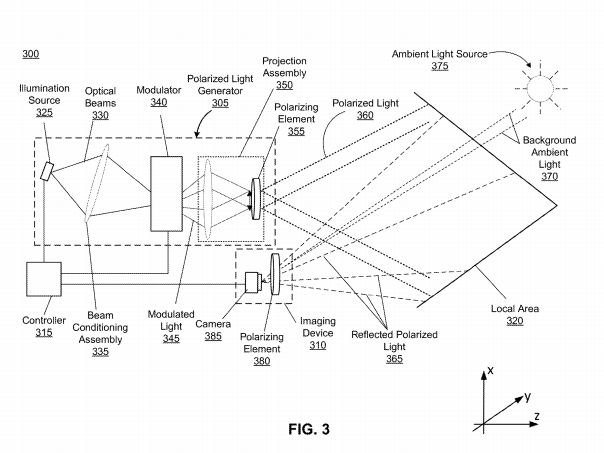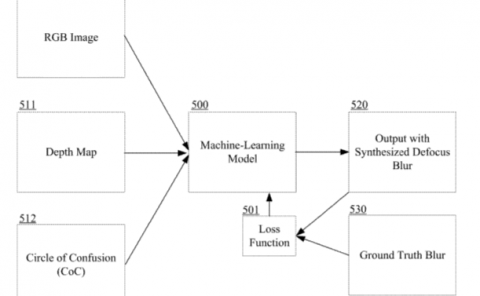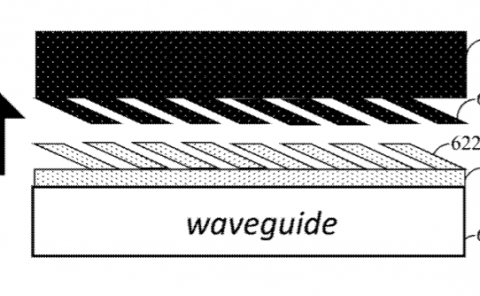Facebook Patent | Circularly polarized illumination and detection for depth sensing
Patent: Circularly polarized illumination and detection for depth sensing
Publication Number: 10181200
Publication Date: 2019-01-15
Applicants: Facebook

Abstract
A depth camera assembly (DCA) for depth sensing of a local area. The DCA includes a polarized light generator, an imaging device, and a controller. The polarized light generator modulates one or more optical beams emitted from an illumination source to generate modulated light, and projects the modulated light into the local area as polarized light having a first polarization. The imaging device receives light from the local area, the received light including ambient light and a portion of the polarized light reflected from the local area. The imaging device reduces an intensity of the received light having polarization different from a second polarization to generate filtered light substantially composed of light of the second polarization, and detects the portion of the polarized light having the second polarization using the filtered light. The controller determines depth information for the local area based on the detected portion of the polarized light.
Background
The present disclosure generally relates to depth sensing, and specifically relates to circularly polarized illumination and detection for depth sensing.
To achieve compelling augmented reality (AR) and virtual reality (VR) user experiences, it is desired to create a depth sensing device that can determine a dense three-dimensional mapping in both indoor and outdoor surroundings. A depth camera usually involves structured light illumination, which is a triangulation technique that makes use of an active illumination source to project known patterns into a scene. The depth camera typically utilizes a two-dimensional pixel array detector to measure and record light back-scattered from one or more objects in the scene. Other methods for depth sensing are based on a time-of-flight technique, which measures a round trip travel time-of-light projected into the scene and returning to pixels on a sensor array. The problem related to the depth sensing methods based on structured light illumination and time-of-flight is related to designing a compact and efficient depth camera that can produce quality depth maps in both indoor and outdoor environments where background ambient light can strongly interfere depth measurements. The depth map obtained in these environments typically have large depth errors and a low level of signal-to-noise ratio (SNR) due to the strong background ambient light.
Summary
A depth camera assembly (DCA) determines depth information associated with one or more objects in a local area. The DCA comprises a polarized light generator, an imaging device and a controller.
The polarized light generator is configured to illuminate the local area with polarized light in accordance with emission instructions. The polarized light generator comprises an illumination source, a modulator, and a projection assembly. The illumination source is configured to emit one or more optical beams. In some embodiments, the illumination source directly generates the one or more optical beams as light of a certain polarization, e.g., based on a polarizing element integrated into the illumination source or placed in front of the illumination source. The modulator is configured to modulate the one or more optical beams based in part on the emission instructions to form a modulated light for scanning the local area. In some embodiments, the modulator is configured as a diffractive optical element that diffracts the one or more optical beams based in part on the emission instructions to generate a diffracted light for scanning the local area with a wide field-of-view. In some embodiments, the modulator includes a polarizing element for generating the modulated light as the polarized light using the one or more optical beams, based in part on the emission instructions. In some embodiments, the modulator configured as an acousto-optic deflector directly generates the modulated light as the polarized light without any additional polarizing element. In alternate embodiments, the modulator can be configured as a liquid crystal grating device that directly generates the modulated light as the polarized light without any additional polarizing element. The projection assembly is configured to project the polarized light into the local area. In some embodiments, the projection assembly includes the polarizing element for generating the polarized light using the modulated light generated by the modulator as un-polarized light. The polarized light projected into the local area has a first polarization, e.g., circular polarization.
The imaging device is configured to capture portions of the polarized light reflected from the one or more objects in the local area. The imaging device includes another polarizing element and a detector. The other polarizing element of the imaging device is configured to receive light from the local area, the received light including ambient light and a portion of the polarized light reflected from the one or more objects in the local area. The other polarizing element of the imaging device is also configured to reduce an intensity of the received light having polarization different from a second polarization (e.g., the ambient light) to generate filtered light substantially composed of light of the second polarization. In some embodiments, the polarizing element blocks the ambient light for reaching the detector. The detector is configured to detect the portion of the polarized light reflected from the one or more objects in the local area having the second polarization using the filtered light. The controller may be coupled to both the polarized light generator and the imaging device. The controller generates the emission instructions and provides the emission instructions to the polarized light generator. The controller is also configured to determine depth information for the one or more objects based at least in part on the detected portion of the reflected polarized light.
A head-mounted display (HMD) can further integrate the DCA. The HMD further includes an electronic display and an optical assembly. The HMD may be, e.g., a virtual reality (VR) system, an augmented reality (AR) system, a mixed reality (MR) system, or some combination thereof. The electronic display is configured to emit image light. The optical assembly is configured to direct the image light to an exit pupil of the HMD corresponding to a location of a user’s eye, the image light comprising the depth information of the one or more objects in the local area determined by the DCA.



